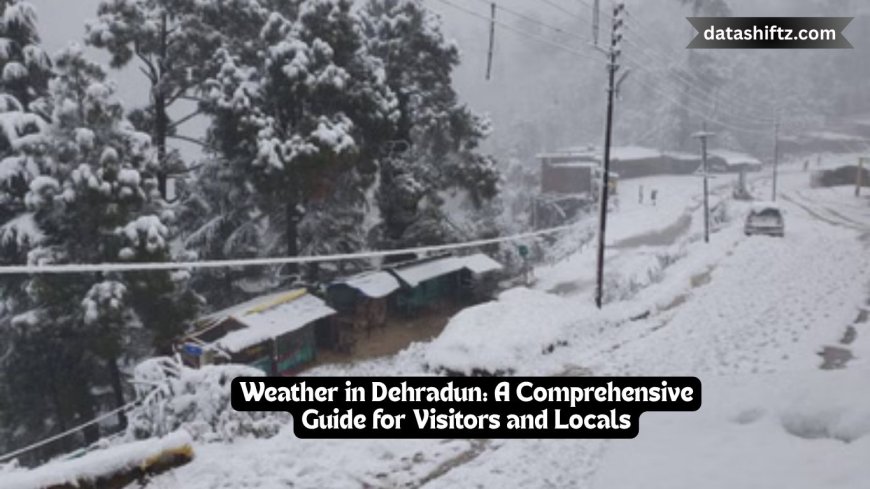Weather in Dehradun: A Comprehensive Guide for Visitors and Locals

Nestled in the foothills of the Himalayas, Dehradun is one of the most scenic and climatically diverse cities in India. Known for its lush greenery, picturesque landscapes, and proximity to hill stations like Mussoorie and Rishikesh, Dehradun offers a weather pattern that is both charming and dynamic. This blog aims to provide a detailed overview of Dehradun’s weather year-round, helping tourists, students, and residents plan their time effectively.
Understanding Dehradun's Climate
Dehradun enjoys a humid subtropical climate influenced by its elevation and geographical location. The city sits at an altitude of around 640 meters (2,100 feet) above sea level, which gives it a moderate and comfortable climate compared to the plains.
The year in Dehradun can be broadly divided into four major seasons:
-
Summer (March to June)
-
Monsoon (July to September)
-
Autumn/Winter (October to February)
-
Spring (Late February to Early March)
Monthly Weather Overview of Dehradun
Below is a monthly temperature and rainfall chart to give you a quick idea of what to expect weather-wise:
| Month | Avg High (°C) | Avg Low (°C) | Rainfall (mm) |
|---|---|---|---|
| January | 18 | 5 | 50 |
| February | 21 | 8 | 60 |
| March | 26 | 12 | 65 |
| April | 32 | 17 | 30 |
| May | 36 | 21 | 40 |
| June | 35 | 24 | 100 |
| July | 30 | 23 | 400 |
| August | 29 | 22 | 450 |
| September | 30 | 21 | 300 |
| October | 29 | 16 | 40 |
| November | 24 | 11 | 15 |
| December | 20 | 7 | 20 |
Seasonal Weather in Dehradun
Summer: March to June
Summer in Dehradun is warm but generally not unbearably hot due to the surrounding hills. Temperatures can rise to 36°C in May, but the evenings remain cooler and pleasant.
What to expect:
-
Dry weather
-
Sunny days
-
Ideal for sightseeing and trekking
Tips:
-
Wear light cotton clothes
-
Stay hydrated
-
Use sunscreen and sunglasses
Monsoon: July to September
The monsoon brings a dramatic transformation to the region. The temperature drops, but the city experiences heavy rainfall, especially in July and August, often exceeding 400 mm per month.
Pros:
-
Lush greenery
-
Romantic atmosphere
-
Fewer tourists
Cons:
-
Risk of landslides in surrounding hilly areas
-
Delayed transportation
-
High humidity
Tip: Carry waterproof clothing and plan extra travel time.
Autumn and Winter: October to February
This is arguably the best time to visit Dehradun. The skies are clear, the temperature is crisp, and the landscape is stunning.
Winter temperatures can drop to around 5°C, especially in December and January. Light fog in the mornings is common, adding a mystical feel to the valley.
What to do:
-
Explore cafes and local markets
-
Visit nearby hill stations (Mussoorie, Dhanaulti)
-
Attend festivals and fairs
Pack: Woolens, jackets, and scarves.
Spring: Late February to Early March
A brief but beautiful season, spring in Dehradun is vibrant, with blooming flowers and rising temperatures. It's a transition phase between winter chill and summer warmth.
Activities:
-
Photography
-
Nature walks
-
Outdoor picnics
Advantages of Dehradun’s Weather
Here’s a quick list of reasons why people love Dehradun’s climate:
-
✅ Pleasant summers
-
✅ Cool, misty winters
-
✅ Beautiful monsoons
-
✅ Year-round greenery
-
✅ Clean mountain air
-
✅ Ideal for health and wellness retreats
How Weather Impacts Life in Dehradun
Agriculture and Horticulture
The moderate climate supports a variety of crops and fruits like litchis, mangoes, and basmati rice. The monsoon plays a crucial role in irrigation but can also pose a threat due to over-rainfall.
Education and Tourism
Dehradun is home to some of India’s most prestigious schools and institutions like Doon School and Forest Research Institute. Students from across India and abroad prefer Dehradun for its healthy, conducive weather and peaceful environment.
Tourism peaks during:
-
Spring and Autumn: Ideal for treks and cultural experiences
-
Winter: Preferred by honeymooners and those escaping hotter plains
Real Estate and Migration
Due to its favourable weather, Dehradun has seen a rise in retirees and professionals settling here. It’s often seen as a retirement paradise due to its clean air, pleasant temperatures, and lower pollution levels compared to metro cities.
Weather-Ready Travel Tips for Dehradun
Whether you’re visiting for a short trip or planning to move permanently, here are some practical weather tips:
-
Check real-time weather updates before your trip.
-
Carry layered clothing – temperatures can vary within a day.
-
If traveling during the monsoon, be cautious of landslide-prone areas.
-
Keep mosquito repellents handy during humid months.
-
Always have an umbrella or raincoat if traveling between July–September.
-
Book accommodations with heaters during winter stays.
-
Use eco-friendly sun protection in summer, especially if hiking.
Final Thoughts
Dehradun’s weather is one of its biggest assets, offering a mix of all seasons without the extremes found in many other parts of India. Whether you're looking for a summer getaway, a cozy winter retreat, or a lush monsoon escape, Dehradun welcomes you year-round with open arms and ever-changing skies.






























